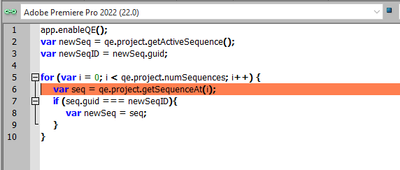- Home
- Premiere Pro
- Discussions
- get specific sequence with qe dom, extendscript
- get specific sequence with qe dom, extendscript
Copy link to clipboard
Copied
Is there a way to get a specific sequence with the qe dom rather than just the active sequence?
var seq = qe.project.getActiveSequence();
Then you will have access to: addTracks()
the problem here is im not trying to get the active sequence
for (var i = 0; i < qe.project.sequences.numSequences; i++) {
var seq = qe.project.sequences[i];
if (seq.sequenceID === newSeqID){
var newSeq = seq;
}
}
This works:
for (var i = 0; i < app.project.sequences.numSequences; i++) {
var seq = app.project.sequences[i];
if (seq.sequenceID === newSeqID){
var newSeq = seq;
}
}
my goal is to get the sequence using qeDOM so I can addTracks specified here:
https://community.adobe.com/t5/premiere-pro/add-a-track-in-a-sequence-extendscript/m-p/11313647?page...
I made a seperate post here just in case some one else had the same question they can find it easier let me know if I should take it down 🙂
 3 Correct answers
3 Correct answers
QE DOM remains, officially, unsupported.
I think you may have better luck trying to find a QE DOM sequence based on its .guid member...
app.enableQE();
var newSeq = qe.project.getActiveSequence();
var newSeqID = newSeq.guid;
for (var i = 0; i < qe.project.numSequences; i++) {
var seq = qe.project.getSequenceAt(i);
if (seq.guid === newSeqID){
var newSeq = seq;
}
}
I feel confident in saying that no additional work is planned on the unsupported, undocumented PPro ExtendScript QE DOM.
Strange, works here. Perhaps it's something specific to that project.
Copy link to clipboard
Copied
QE DOM remains, officially, unsupported.
I think you may have better luck trying to find a QE DOM sequence based on its .guid member...
app.enableQE();
var newSeq = qe.project.getActiveSequence();
var newSeqID = newSeq.guid;
for (var i = 0; i < qe.project.numSequences; i++) {
var seq = qe.project.getSequenceAt(i);
if (seq.guid === newSeqID){
var newSeq = seq;
}
}
Copy link to clipboard
Copied
I just stumbled over the same problem.
It seem that qe holds the sequences per bin and adjusts the numSequences count accordingly.
Except for the root bin/project item.
From what I am seeing numSequences instead holds the total count of the whole hierarchy there while every sub bin only shows the number of sequences on its own level and does not total the sub levels (which would be the correct way, given how getSequenceAt() is implemented.
For the following heirachy this leads to having a numSequences of 4 for qe.project, but qe.project.getSequenceAt(1) failing, since it only can access the one at index 0:
project (root bin) (numSequences=4, only one sequence accessible via getSequenceAt() despite numSequences=4)
seq1
> bin1 (numSequences=1)
> seq2
> bin1_2 (numSequences=2)
> seq3
> seq4
So your example above should fail when any sequences are sorted into bins.
The only way I see how one could walk over all sequences is to first traverse all sub bins, count the found items and at the end ask the project bin for the remaining number of sequences.
Since that's bit cumbersome, it just looks like a bug in the implementation of numSequences vs getSequenceAt() on the root/project level. The count implementing a totaled perpesctive, while getSequenceAt() delivering a local one. Probably due to a mixup of the bin an project levels on that level in the QE DOM.
Can you confirm that this is a bug in the QE implementation?
Copy link to clipboard
Copied
> Can you confirm that this is a bug in the QE implementation?
That seems correct.
Copy link to clipboard
Copied
Ah, so fast that I couldn't even correct my typos..
Will that QE behaviour be "fixed" or can we rely on it staying that way and it being augmented instead?
(The answer probably goes towards "rely" and "assume" not fitting the QE approach, but I give it a try...)
Copy link to clipboard
Copied
I feel confident in saying that no additional work is planned on the unsupported, undocumented PPro ExtendScript QE DOM.
Copy link to clipboard
Copied
Thanks. Good to know.
Copy link to clipboard
Copied
Hi, i just let you know that this code does not work in PP2022.
Copy link to clipboard
Copied
Strange, works here. Perhaps it's something specific to that project.
Copy link to clipboard
Copied
Copy link to clipboard
Copied
Never mind, it is working !
You can see in the screen shot, I had
after the
app.enableQE(); ( should be before. )
Copy link to clipboard
Copied
Thanks so much for the response! I am truly grateful.
I create a new sequence using :
var newSeq = qe.project.newSequence(seqName, presetPath);
Is there any better way I feel like I am close but I cant figure it out
app.enableQE();
var seqName = 'test_sequence_new';
// qe dom to add new sequence with pre-defined preset
qe.project.newSequence(seqName, presetPath);
var originalSeq = $._PPP_.getSequenceByID(originalSeqID);
// get new qe dom sequence by name
for (var i = 0; i < qe.project.numSequences; i++) {
var seq = qe.project.getSequenceAt(i);
if (seq.name === seqName){
var newSeq = seq;
}
}
Copy link to clipboard
Copied
Again, QE DOM will remain officially unsupported...
I suspect that your new sequence will be the last sequence; qe.project.numSequences - 1.
Copy link to clipboard
Copied
You sir are brilliant.
One note - when I do
I get evalscript Error
when I do
it returns the latest created sequence successfully.
Is there an alternative way other than QE DOM to add tracks to a newly created sequence? Since QE DOM is unsupported?
I use qe.project.newSequence(seqName, presetPath);
to create a new sequence, an alternative of using seq.addTracks(0), I was thinking of changing the actual PProPanel.sqpreset file that I use in presetPath parameter.
Using the preset file it creates 3 video tracks, but I may need a variable N number of video tracks.
in PProPanel.sqpreset I noticed
Any other way to add tracks using PProPanel.sqpreset?
this is what my file looks like:
https://community.adobe.com/t5/premiere-pro/creating-a-sequence-by-linking-to-preset-filepath-issue/...
https://github.com/Adobe-CEP/Samples/blob/master/PProPanel/jsx/PPRO/Premiere.jsx
Get ready! An upgraded Adobe Community experience is coming in January.
Learn more